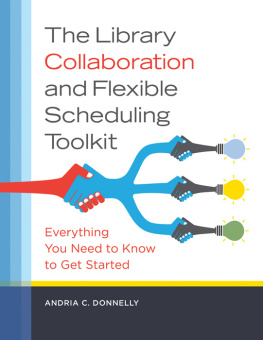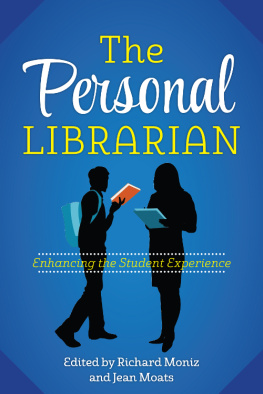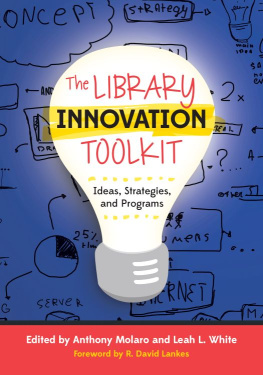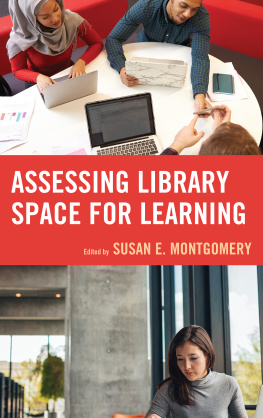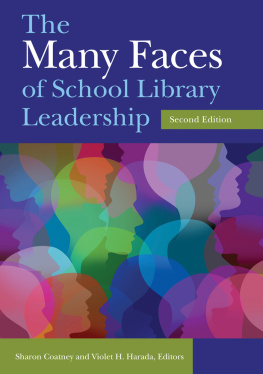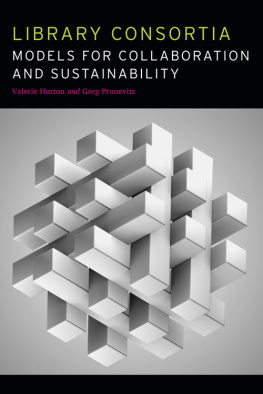The Library Collaboration and Flexible Scheduling Toolkit
The Library Collaboration and Flexible Scheduling Toolkit
Everything You Need to Know to Get Started
Andria C. Donnelly

Copyright 2015 by ABC-CLIO, LLC
All rights reserved. No part of this publication may be reproduced, stored in a retrieval system, or transmitted, in any form or by any means, electronic, mechanical, photocopying, recording, or otherwise, except for the inclusion of brief quotations in a review, without prior permission in writing from the publisher.
Library of Congress Cataloging-in-Publication Data
Donnelly, Andria C.
The library collaboration and flexible scheduling toolkit : everything you need to know to get started / Andria C. Donnelly.
pages cm
Includes bibliographical references and index.
ISBN 978-1-4408-3684-8 (pbk : alk. paper) ISBN 978-1-4408-3685-5 (ebook)
1. School librariesAdministration. 2. Elementary school librariesAdministration. 3. School librariansProfessional relationships. 4. Libraries and teachers. 5. School librarian participation in curriculum planning. 6. Schedules, School. 7. Group work in education. 8. Teaching teams. I. Title.
Z675.S3D66 2015
025.1'978dc23 2014045573
ISBN: 978-1-4408-3684-8
EISBN: 978-1-4408-3685-5
19 18 17 16 15 1 2 3 4 5
This book is also available on the World Wide Web as an eBook.
Visit www.abc-clio.com for details.
Libraries Unlimited
An Imprint of ABC-CLIO, LLC
ABC-CLIO, LLC
130 Cremona Drive, P.O. Box 1911
Santa Barbara, California 93116-1911
This book is printed on acid-free paper 
Manufactured in the United States of America
First, this book is dedicated to God, without whom I would not have the skills to be a collaborative librarian or even attempt to write this book.
Second, this book is dedicated to my husband, who believes in me more than anyone else in this world.
Third, this book is dedicated to my dad, who gave me the gift of a lifetime filled with a love of reading and writing.
Fourth, this book is dedicated to Amanda Jones, who fills my life with laughter and support.
Fifth, this book is dedicated to Michelle Bagley, without her, collaboration and the flexible schedule would not be possible for me.
Sixth, this book is dedicated to supportive principals like mine, James Dallas.
And, finally, this book is dedicated to all those librarians who have the courage to take the first steps toward collaboration and the flexible library schedule.
Contents
At the beginning of each chapter there are questions for the reader to answer. These questions are there for the individual librarian to start the thinking process related to transitioning a library from a fixed library schedule that is noncollaborative to a flexible schedule that utilizes collaboration and student achievement as the driving force behind the daily work in the library. These questions are there to help the reader determine what needs to be done or thought about to shift from one model of services to the other.
My personal answers to many of these questions will be shared throughout the book. However, some of the questions can only be answered by the individual librarian, as the answers relate to that particular individuals school. The answers to those questions will determine the actions that need to take place to further the schools movement toward collaboration. Some questions may not even relate to the individual readers library program. As we all know, each library is different from every other library, and so one librarians answers to certain questions may be completely different from mine or any other librarians answers because of circumstances beyond the librarians control.
Within the text of each chapter, all resources are directly noted where they apply so that the reader will be able to use the resources immediately and not have to hunt down references in a later portion of the book. Examples of any materials are also noted within the text wherever they are applicable.
I have frequently noticed that there is some confusion about what collaboration and flexible library scheduling mean. Many times these terms are used interchangeably, which can lead to confusion and misunderstandings between the members of the library stakeholders team. They are not defined as the same thing in this book. The definitions at the beginning of each chapter will help the reader to solidify the understandings of all terms necessary to successfully comprehend the rest of the chapter and book. The librarian should make sure that he or she has the terms and definitions firmly settled in his or her mind prior to sharing this understanding with others. To make collaboration a viable success, all stakeholders need to have a shared understanding of what it means to collaborate in the library.
There are many different levels of collaboration; some involve a flexible schedule. The reader needs to determine which level of collaboration he or she would like to attain and set goals to rise to that level. In essence, this book is meant to be a workbook to help the reader achieve the level of collaboration that the reader wants in his or her own library.
After finishing the work for my library credential, I found myself in the exciting position of being on the cusp of a new career filled with many different possibilities. My brain was brimming with the many ideas that I had learned about in my various classes. Those very same classes preached collaboration and a flexible schedule as the most effective practices of the library. After reading much of the research that backed up this claim, I felt ready to go forth and collaborate. As I interviewed with various principals in my school district, it became evident that I was not articulating the importance of collaboration very well. Instead of rushing to hire me, several principals said, No thank you, we wont be doing that in this school (Donnelly 2014).
I now understand that a high level of trust needs to be built up between the principal and the librarian for collaboration and a flexible schedule to succeed, and this includes constant communication regarding collaboration. It was terribly surprising to me that the elementary schools were not interested in something that I had spent quite a bit of time learning about in my various library classes, particularly as there was so much research in support of collaboration and student achievement.
On my last library interview of that year, I met with a principal who felt that collaboration just might increase her standardized test scores in a variety of grade levels, and so began my journey into the world of library collaboration. There was no training for the teachers. They were just told by the principal at a staff meeting that we were changing things and there would be collaboration in the library. This principal was supportive of the idea of collaboration, and as long as it was working, she left me alone to implement and solve problems by myself. However, the moment that problems reached her ears, she began to question whether it was the right way to go.
Some of the problems involved teachers who were unhappy about planning time loss and parents who did not understand what collaboration in the library entailed. I spent many months sharing research with the principal and having her observe collaboration in action. I also backpedaled with the teachers to model new concepts for teaching research and provided as much individual training as I could, one-on-one or in small groups, for those who were receptive to learning more about collaboration and willing to do it well. I must admit that I made many mistakes along the way that I wish I could undo. Some of the mistakes were related to collaboration, and some were just related to being with new staff as an inexperienced librarian. I feel that my years as a classroom teacher and reading specialist minimized some of the damage because the receptive teachers understood that I have a firm teaching background.
Next page
